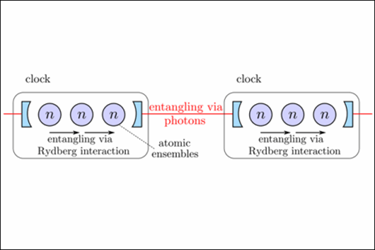Quantum Network Of Atomic Clocks Could Enhance GPS, Gravitational Wave Detection
By Jof Enriquez,
Follow me on Twitter @jofenriq

Physicists have devised a new method to create a quantum network of atomic clocks consisting of ensembles of hundreds of entangled atoms. This network, they claim, is significantly more stable and accurate than existing atomic clocks, and has several critical applications, including the detection of gravitational waves.
In the protocol described in the researchers’ study, published in Physical Review Letters, hundreds of neutral ytterbium atoms inside each ensemble are entangled via the strong dipole-dipole interaction between Rydberg excitations. Then, ensembles themselves are made to entangle through single-photon quantum channels and light-matter couplings. Eventually, all ensembles that make up the whole atomic clock network become fully entangled, resulting in a network that is more stable than current atomic clocks.
"Our work shows that utilizing remote entanglement to improve the accuracy of measuring time is within the reach of current experimental technology," Peter Kómár, a study author and a physicist at Harvard University, told Phys.org. "This result will most certainly encourage further efforts towards constructing a prototype atomic clock quantum network, finding even better implementations and discovering new use cases."
"Superstable atomic clocks allow scientist to measure minuscule changes in the speed of passing time," Kómár added, according to Phys.org. "Although local time always passes with the same rate for the local observer, time often passes with slightly different rates at different locations. Many physical phenomena can cause the passage of time to slow down or speed up, all of which are tied to large masses and gravity."
Komar cites gravitational waves as an example of a phenomenon that causes time to pass at different rates at different locations. Gravitational waves were observed for the first time in September 2015 by the twin detectors of Laser Interferometer Gravitational-wave Observatory (LIGO). LIGO detected tiny ripples in the fabric of spacetime as the gravitational waves passed through the earth. Komar and his colleagues claim that their more precise atomic clocks installed in satellites could also capture these elusive waves just as well.
"A formation of satellites, each equipped with superstable atomic clocks, can be used as a very precise 'space-seismograph.' As the gravitational wave passes through the region occupied by the satellites, their clocks pick up a tiny time difference with respect to each other. This provides a way to detect gravitational waves through the distortions of time as opposed to distortions of space, the method LIGO relies on, providing complementary means of detection," Kómár explained to Phys.org.
He and his colleagues wrote last year in Nature Physics that their proposed global, satellite-based quantum network of clocks is secure from both internal and external threats, and represents a real-time single international time scale (world clock) with unprecedented stability and accuracy.
"Distributed around the Earth and on satellites, the clock network could maintain and synchronize time standards across multiple parties in real-time — a true world clock. Furthermore, by its very nature, this quantum network of atomic clocks would be protected against quantum-cryptographic attacks," stated a Harvard University news release of the research group's proposal.
They also wrote that this type of quantum clock network could be critical in applications such as the Global Positioning System (GPS), as well as in high-frequency financial trading, and in oil exploration.
